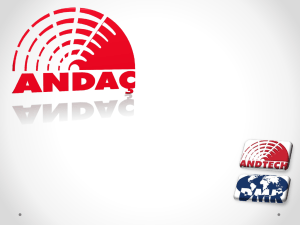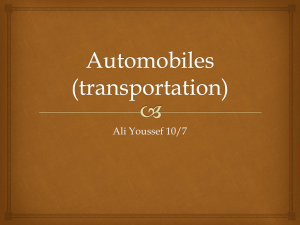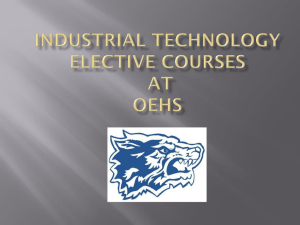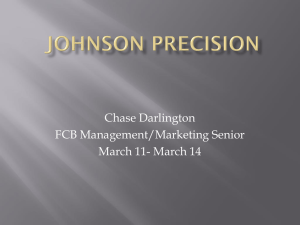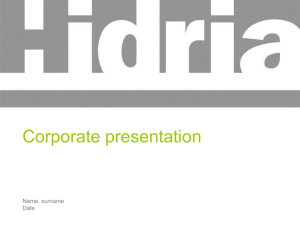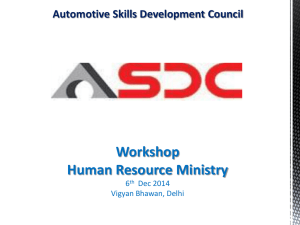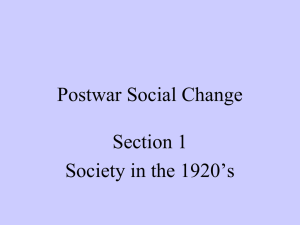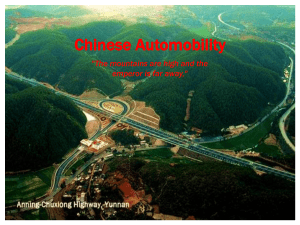Slide 1
advertisement
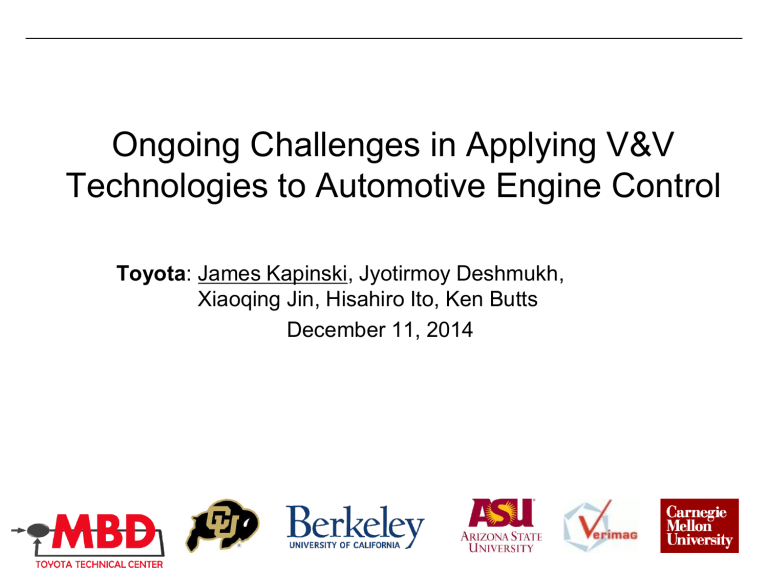
Ongoing Challenges in Applying V&V Technologies to Automotive Engine Control Toyota: James Kapinski, Jyotirmoy Deshmukh, Xiaoqing Jin, Hisahiro Ito, Ken Butts December 11, 2014 Ongoing Challenges in Applying V&V Technologies to Automotive Engine Control Jim Kapinski Toyota MBD Group • Our group focus Toyota Technical Center – Advanced research in V&V for powertrain controller designs • Our group background – Cyber-physical systems (hybrid systems) – Formal verification methods • Our perspective – Focus is on techniques for application-level real-time controller development Powertrain Control Division Model-Based Development Group Verification & Validation 2 Ongoing Challenges in Applying V&V Technologies to Automotive Engine Control Jim Kapinski Ever-Increasing Complexities of Powertrain Control System Fuel economy Emissions Safety Driveability 1988 • • 1997 2002 2009 Need to meet ever-increasing standards -> more complex control code Engine control code in modern engines can be measured in millions of lines of code! 3 Ongoing Challenges in Applying V&V Technologies to Automotive Engine Control Jim Kapinski Features of Powertrain Control Software Development • • Safety critical Single core – But multicore is coming! • Hard real-time – Time-triggered tasks • E.g., P+I control, table lookups – Event triggered tasks • E.g., crank angle events • Not much connectivity – Distribution of features across processors not as significant • • Performance and functionality critically depends on environment Exhaustive test is impossible – Continuous variables over unbounded time ⇒ infinite test cases 4 Ongoing Challenges in Applying V&V Technologies to Automotive Engine Control Jim Kapinski Verification Challenges • Complex models – – – – – Large number of states/inputs Nonlinearities and lots of switching behavior Variable time delays (delay differential equations) Look-up-tables Can contain legacy code or other black-box components • Inconvenient model formats – Many formal tools require format that can be translated into a discrete-state representation or a hybrid automaton – Simulink semantics are closed – Translating formats is time consuming and error prone • Lack of formal requirements – More on this later… 5 Ongoing Challenges in Applying V&V Technologies to Automotive Engine Control Jim Kapinski Value of Simulation • Helps design validation – Vital part of control law development • Can uncover bugs • Does not require verification domain knowledge – Engineers are not familiar with © The MathWorks • Temporal logic, bounded model checking, theorem provers • Simulations are cheap and usually fast • Test-suites can be shared and built up across models 6 Ongoing Challenges in Applying V&V Technologies to Automotive Engine Control Jim Kapinski Using Simulation for Test and Verification • Let’s use simulation to guide verification and testing approaches • NOT a fundamentally new idea: – – – – – – – Concolic Testing: Sen et al, Kanade et al Proofs from tests: (Gupta, Rupak, Rybalchenko) Falsification analysis: (S-TaLiRo: Georgios, Sriram) Sensitivity-based analysis (Breach: Donzé, Maler) Coverage-guided simulation (Thao Dang et al) Sciduction – combining induction and deduction (Seshia, Jha) …. (please pardon the omissions) 7 Ongoing Challenges in Applying V&V Technologies to Automotive Engine Control Jim Kapinski Spectrum of Analysis Techniques More Scalable Testing/Control Techniques • Simulation • Linear Analysis (numerical) • Test Vector Generation for Model Coverage Less Scalable • Linear Analysis (symbolic) • Concolic Testing • (Bounded) Model Checking • Stability Proofs • Reachability Analysis Less formal/exhaustive 8/60 Verification • Theorem Proving More formal/exhaustive Ongoing Challenges in Applying V&V Technologies to Automotive Engine Control Jim Kapinski Spectrum of Analysis Techniques More Scalable Testing/Control Techniques • Simulation • Linear Analysis (numerical) • Test Vector Generation for Model Coverage Less Scalable • Linear Analysis (symbolic) • Trajectory Splicing • Coverage-based Testing • Concolic Testing • Simulation-Guided Lyapunov/Contraction Analysis • (Bounded) Model Checking • Stability Proofs • Reachability Analysis Less formal/exhaustive 9/60 Verification • Theorem Proving More formal/exhaustive Ongoing Challenges in Applying V&V Technologies to Automotive Engine Control Jim Kapinski Spectrum of Analysis Techniques More Scalable Testing/Control Techniques Simulation traces to learn contraction metrics for dynamical systems Using simulation segments to efficiently • Simulation search for counterexamples A. Zutshi, S. Sankaranarayanan, J. Deshmukh, and J. Kapinski. Multiple Shooting, CEGAR-based • Linear Falsification for Hybrid Systems.Analysis Best Paper in EMSOFT 2014. (numerical) • Test Vector Generation for Model Coverage Less Scalable T. Dreossi, T. Dang, A. Donze, J. Kapinski, X. Jin, J. Deshmukh. Efficient Guiding Strategies for Testing of Temporal Properties of Hybrid Systems. Submitted to the 2015 NASA Formal Methods Symposium. 10/60 A. Balkan, J. Deshmukh, J. Kapinski, P. Tabuada. Simulation-guided Contraction Analysis. To appear in the 2015 Indian Control Conference. • Trajectory Splicing • Coverage-based Testing LineartoAnalysis Simulation-based •testing maximize coverage of infinite state-space (symbolic) Less formal/exhaustive Verification • Concolic Testing • Simulation-Guided Lyapunov/Contraction Analysis • (Bounded) Model Using simulation traces Checking • Stability to learn Lyapunov functions andProofs barrier certificates • Theorem Kapinski,• J. V. Deshmukh, S. Reachability Proving Sankaranarayanan, and N. Analysis Aŕechiga. Simulation-guided Lyapunov Analysis for Hybrid Dynamical Systems. In HybridMore formal/exhaustive Systems: Computation and Control, 2014. Ongoing Challenges in Applying V&V Technologies to Automotive Engine Control Jim Kapinski CPS Requirement Challenges ? Implementation ⊨ Requirements Implementation Implementation Requirements Verification Tool Classic Verification Assumption 11 Ongoing Challenges in Applying V&V Technologies to Automotive Engine Control Jim Kapinski CPS Requirement Challenges Results from Integration Tests Informal Engineering Insight Implementation Implementation Simulationbased checks Incomplete Requirements The Reality for CPS 12 Ongoing Challenges in Applying V&V Technologies to Automotive Engine Control Jim Kapinski CPS Requirement Challenges • Requirements are evolving due to CPS-related issues – Environment/software designs evolve concurrently – Not possible to create a plant model that captures all behaviors – Subtle interactions between states/signals are not known before integration test • Definition of correct behaviors exist only in engineer’s brain – Formal requirements are hard for engineers to develop – Existing requirements do not capture all of the desired behaviors • Model may capture appropriate/expected behavior but requirements do not 13 Ongoing Challenges in Applying V&V Technologies to Automotive Engine Control Jim Kapinski CPS Requirement Challenges • Requirements are evolving due to CPS-related issues – Environment/software designs evolve concurrently – Not possible to create a plant model that captures all behaviors – Subtle interactions between states/signals are not known before integration test • Definition of correct behaviors exist only in engineer’s brain – Formal requirements are hard for engineers to develop – Existing requirements do not capture all of the desired behaviors Let’s look at some ideas to address this • Model may capture appropriate/expected behavior but requirements do not 14 Ongoing Challenges in Applying V&V Technologies to Automotive Engine Control Jim Kapinski Requirement Mining† • Sometimes requirements are not in format needed to perform formal verification Simulink Model Seed Traces – Would be useful to automatically obtain formal specifications • Our approach is simulationbased Simulation Traces Obtain tightest parameter for given traces Counter-example Traces Counterexample Found Falsify requirement using a global optimizer Candidate Requirement No Counter-example e.g., Overshoot=?, Settling time=? Template Requirement e.g., Overshoot=5%, Settling time=0.2 sec. Inferred Requirement † X. Jin, A. Donze, J. V. Deshmukh, and S. A. Seshia. Mining Requirements from Closed-Loop Control Models. In Hybrid Systems: Computation and Control 2013. 15 Ongoing Challenges in Applying V&V Technologies to Automotive Engine Control Jim Kapinski Learning Requirements • Learning STL requirements from traces – Optimization-guided learning • Enumerate PSTL formulas up to a certain length (i.e., number of nodes in parse tree of formula) • Use Requirement Mining to mine parameter values from traces • Select best feasible formula Learning Tool STL requirement Traces from Engineer 16 Ongoing Challenges in Applying V&V Technologies to Automotive Engine Control Jim Kapinski Summary • Many V&V challenges for powertrain systems – Due to CPS nature of systems & high complexity – We are encouraged by simulation-guided approaches • Requirements engineering poses significant challenges – Can’t assume we have a thorough set of formal requirements – Let’s consider simulation-guided approaches 17 Ongoing Challenges in Applying V&V Technologies to Automotive Engine Control Jim Kapinski Thank You! • A benchmark powertrain control model described in: – X. Jin, J. Deshmukh, J. Kapinski, K. Ueda, and K. Butts. Powertrain Control Verification Benchmark. In Hybrid Systems: Computation and Control, 2014. • A version of the benchmark model can be found on the Applied Verification for Continuous and Hybrid Systems (ARCH) site: – http://cps-vo.org/group/ARCH – Paper: http://cps-vo.org/node/12108 – Models: http://cps-vo.org/node/12119 18
